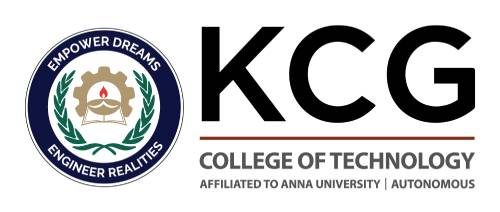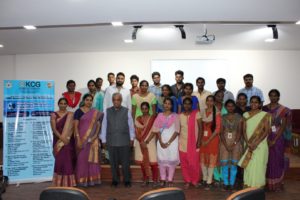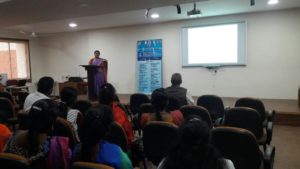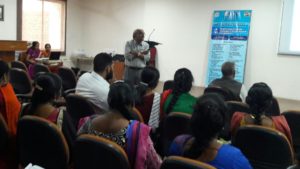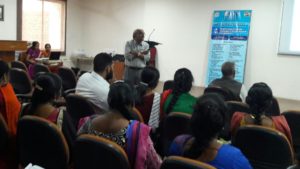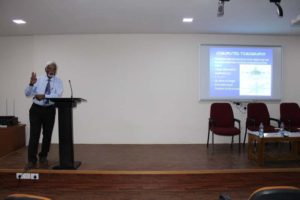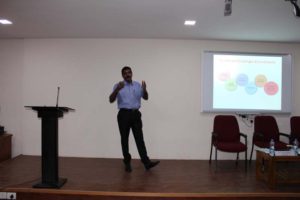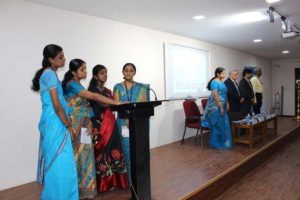The Department of Electrical and Electronics Engineering, KCG College of Technology organized ICMR sponsored Three Day Workshop on “MEDICAL IMAGE PROCESSING TECHNIQUES IN CLINICAL RESEARCH AND HEALTH CARE” from 14th – 16th September 2017. The inaugural function commenced at 9.30 am in Seminar Hall-I. The meeting was presided over by Dr. G. Prabhakaran, Principal and inaugurated by the Chief Guest, Dr. T. R. Muralidharan, Senior Consultant and Head, Department of Cardiology, Sri Ramachandra University. The meeting formally begun with an invocation and the invited guests were welcomed by Dr. P. Deiva Sundari, Professor & Head, Department of EEE. . Dr. G. Prabhakaran, Principal and Dr. G. Sambandan, Advisor – Electrical Sciences offered felicitations. Around 25 participants registered for the programme. Most of the participants were Faculty from academic Institutions, Research Scholars, PG and UG students. The Chief Guest shared his views in the field of medical image processing and current research methodologies available.
The detailed report of the sessions are as follows:
Day 1 – Session 1
Ms. Prof. Kuppusamy Thayalan, Consultant Medical Physicist – Kamakshi Memorial Hospital
He introduced the technological perspectives of Medical Imaging. The development of modern radiographic imaging, the basic physical principles behind common approaches to imaging, including Computed Tomography (CT), Ultrasound, and Magnetic Resonance Imaging (MRI), and the pros and cons of each technique were explained by him. Students consider the broader picture behind bringing imaging into clinical use, such as animal testing, human trials, costs, and the requirement of training technicians. Medical imaging in general is rich with applications of engineering and physics because the instrumentation is technically complex. Many of the body’s systems and functions can be modelled, controlled, and investigated using engineering principles and methods. The instrumentation that is used to deliver health care is also very technical and rapidly evolving. As a result, engineering is becoming an increasingly important field of study in both biomedical research and medical delivery at all levels of the health-care system.
Session II
Dr. Y. Sreenivasa Varma, Medical Director, Balagangadhara Varma Nursing Home and Research Centre
He started the session by stating the definition of health, health care challenges and constraints. He emphasized that technology is driving a new paradigm to create better healthcare. He focussed on the basic two approaches in medical innovation: Linear and Technology adoption approaches. He also focussed on the basic two approaches to medicine: Clinical and Molecular approaches. He mentioned that technology helps doctors’ to have better decision making, improving patient and provider interaction and integrating preventive health care tools as clinical reminders. He explained about the top trends in the areas of medical research like image and signal processing, bio medical sensors, IOT and Big data analytics, Artificial Intelligence, Genomics, stem cell therapy and tissue engineering. He explained the advancements in imaging techniques, bio sensors, bio sensing wearables, health care big data challenges.
Session III
Dr. M. Sasikala, Associate Professor, Department of ECE, Anna University
She gave an idea about Thermal Imaging and its Applications to Breast Cancer Detection. Body temperature is a natural criterion for the diagnosis of diseases. Thermal imaging (thermograph) applies infrared method which is fast, non-invasive, and non-contact and flexible to monitor the temperature of the human body. Historically, temperature is a very good health indicator. Body produces heat and body temperature may be different from the surrounding temperature. The core temperature is maintained within a narrow range of about 33°C to 42°C. Abnormal thermal patterns can be easily detected by thermal imaging. The results of thermal measurement in general compared with other clinical findings to assess the possible correlation. Although the method is non-specific and environment can affect its results, there are several reasons which have caused thermal imaging to be accepted widely among the medical community. First of all, thermal imaging is noncontact, non-invasive method and can be used from far way.
She explained about the different image processing techniques used in thermo graphic images for breast cancer detection. The different thermo graphic image patterns for the normal and abnormal portion of the body were shown. The features to identify the abnormality were also clearly explained.
Session IV
Dr. Sheeja V Francis, Associate Professor, Department of ECE, MNM Jain Engineering College.
Her topic was Feature Extraction and Selection Algorithms adopted in Images. She summarised various ways of performing dimensionality reduction on high-dimensional microarray data. Many different feature selection and feature extraction methods exist and they are being widely used in clinical and health care systems. All these methods aim to remove redundant and irrelevant features so that classification of new instances will be more accurate. A popular source of data is microarrays, a biological platform for gathering gene expressions. Analysing microarrays can be difficult due to the size of the data they provide. In addition the complicated relations among the different genes make analysis more difficult and removing excess features can improve the quality of the results. She presented some of the most popular methods for selecting significant features and provides a comparison between them. Their advantages and disadvantages are outlined in order to provide a clearer idea of when to use each one of them for saving computational time and resources.
Day –II
Session V: Prof. V. Rajendran, Professor and Head, Department of ECE, Vels University
He addressed the importance of detecting the presence of solid deposit of calcium radicals grouped in certain way in breast tissue. He explained the principles of digital images and analysis of digital imaging processing operation. He explained a case study done titled automated simulation model using CAD techniques, Analysis on cyst using sonomammogram. He explained novel automated algorithm using CAD Technique to find 3D pattern recognition of lesion part using physical characteristics.
Session VI: Dr. T. Jayanthi, Assistant Professor, Department of Bio Medical Engineering, SRM University
She explained about Infra-Red Thermal Imaging for cardio vascular disorders. She discussed in detail about the following:
- Prevalence of CVD
- Standard Diagnostic Methods
- Infrared thermal imaging
- Potential of IR in diagnosing CVD
- Static thermal imaging
- Dynamic thermal imaging
- IR and hypertension
- IR and its scope for research
Session VII & VIII:
Mr. AS Subramanian & Mr. V. Vaanmugil, Siemens Healthineers
Mr.AS Subramanian explained about the different imaging equipments available from the earlier days to the recent ones. He also gave a detailed idea about how these equipments are used.
Mr.Vaanmugil explained about the company portfolio and the recent equipments that are available with them.
|
Day –III Session IX: Dr V Sathiesh Kumar Professor, Department of Electronics Engineering, Madras Institute of Technology Basics of Imaging Processing using open CV and PYTHON Programming It was a Tutorial Session from 9 am to 12 noon on the basics of computer vision in Python programming. It included an introduction to Open CV, tutorial on image basics, drawing, basic operations on image resizing, masking, merging, kernels etc. and how it is been used in the image processing field.
Session X: Dr. M. Ramasubba Reddy Professor, Department of Applied Mechanics, IIT Madras. He gave a presentation related to Ultrasound Stiffness Imaging Techniques. He emphasized on basics of ultrasound imaging process. He explained with respect to diagnosis of lesions using ARFI Imaging. He explained about Manual palpation and method of Elastography. A detailed analysis of steps in Elastography was presented. He presented a case study with results from an experiment obtained from a tissue mimicking phantom. He briefed about the breast cancer diagnostic technique (X- Ray mammography) comparison of Elastography with ultrasound process.
|







